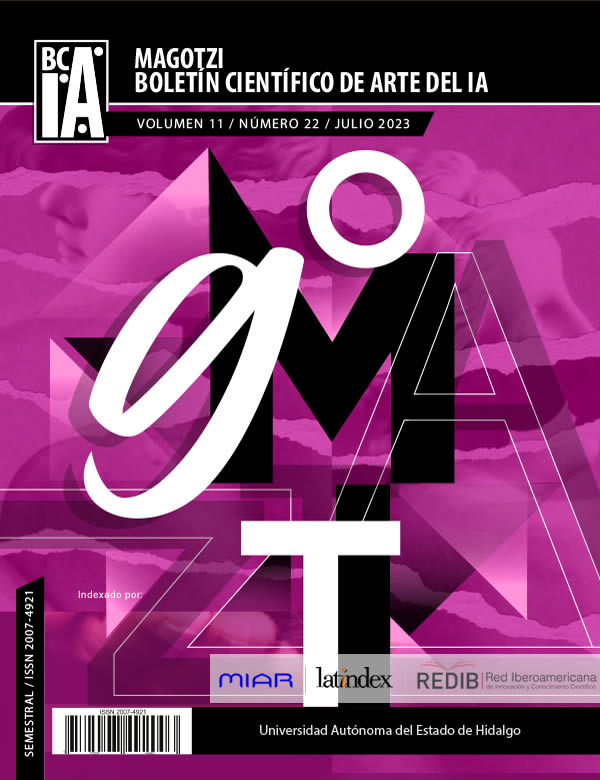La lectura musical y la complejidad en la partitura
Un modelo de validez ecológica para las mediciones de complejidad en música escrita
DOI:
https://doi.org/10.29057/ia.v11i22.10638Palabras clave:
Notación musical, complejidad, amplitud perceptual, memoria de trabajoResumen
Presentamos un modelo que permite dividir el contenido de la partitura automáticamente, basado en las ideas más recientes de lectura, cognición y complejidad musicales. Relacionando la “amplitud perceptual” y la “memoria de trabajo”, somos capaces de encontrar umbrales precisos, que pueden ser utilizados para evaluar la complejidad de música leída. El modelo se ajusta a los requerimientos de validez ecológica para los cálculos que evalúan la complejidad en música escrita y la validación muestra que el mismo es aplicable a fragmentos fáciles y difíciles escritos con notación musical.
Descargas
Información de Publicación
Perfiles de revisores N/D
Declaraciones del autor
Indexado en
- Sociedad académica
- N/D
Citas
Angeler, D. G. (2020). Biodiversity in Music Scores. Challenges, 11(1), 7. https://doi.org/10.3390/challe11010007
Ávila Cascajares, F. S. (2021). Capacidad de memoria y estrategias de instrumentistas y no músicos en pruebas auditivas de Sternberg modificadas con unidades significativas musicales y verbales. Tesis de maestría en cognición musical: UNAM.
Bennett, D., Gobet, F., & Lane, P. C. R. (2020). Forming Concepts of Mozart and Homer Using Short-Term and Long-Term Memory: A Computational Model Based on Chunking. In S. Denison, M. Mack, Y. Xu, & B. C. Armstrong (Eds.), Proceedings of the 42th Annual Meeting of the Cognitive Science Society—Developing a Mind: Learning in Humans, Animals, and Machines, CogSci 2020, virtual, July 29—August 1, 2020.
Burman, D. D., & Booth, J. R. (2009). Music Rehearsal Increases the Perceptual Span for Notation. Music Perception, 26(4), 303–320. https://doi.org/10.1525/mp.2009.26.4.303
Chang, T.-Y., & Gauthier, I. (2021). Domain-specific and domain-general contributions to reading musical notation. Attention, Perception, & Psychophysics. https://doi.org/10.3758/s13414-021-02349-3
Chase, I. D. (2006). Music notation: A new method for visualizing social interaction in animals and humans. Frontiers in Zoology, 3(1), 18. https://doi.org/10.1186/1742-9994-3-18
Chitalkina, N., Puurtinen, M., Gruber, H., & Bednarik, R. (2020). Handling of incongruences in music notation during singing or playing. International Journal of Music Education, 39(1), 18–38. https://doi.org/10.1177/0255761420944036
Dover publications. (1983). Ludwig van Beethovens Werke, Serie 9, Nr.67. Leipzig: Breitkopf und Härtel, n.d.[1862]. Plate B.67. dominio público, acceso desde https://imslp.org/wiki/Piano_Concerto_No.3%2C_Op.37_(Beethoven%2C_Ludwig_van), acceso 2022-01-01.
Eden Ünlü, S., & Ece, A. S. (2019). Reading notation with Gestalt perception principles: Gestalt algı ilkeleri ile notasyon okuma. Journal of Human Sciences, 16(4), 1104–1120. https://doi.org/10.14687/jhs.v16i4.5822
Gunter, T. C., Schmidt, B.-H., & Besson, M. (2003). Let’s face the music: A behavioral and electrophysiological exploration of score reading. Psychophysiology, 40(5), Article 5. https://doi.org/10.1111/1469-8986.00074
Hattie, J. (2008). Visible learning: A synthesis of over 800 meta-analyses relating to achievement. Routledge.
Holder, E., Tilevich, E., & Gillick, A. (2015). Musiplectics: Computational assessment of the complexity of music scores. 2015 ACM International Symposium on New Ideas, New Paradigms, and Reflections on Programming and Software (Onward!) - Onward! 2015, 107–120. https://doi.org/10.1145/2814228.2814243
Ishiguro, Y., & Rekimoto, J. (2011). Peripheral vision annotation: Noninterference information presentation method for mobile augmented reality. Proceedings of the 2nd Augmented Human International Conference on - AH ’11, 1–5. https://doi.org/10.1145/1959826.1959834
Janurik, M., Surján, N., & Józsa, K. (2022). The Relationship between Early Word Reading, Phonological Awareness, Early Music Reading and Musical Aptitude. Journal of Intelligence, 10(3), 50. https://doi.org/10.3390/jintelligence10030050
Laske, O. E. (1988). Introduction to Cognitive Musicology. Computer Music Journal, 12(1), 43. https://doi.org/10.2307/3679836
Lerdahl, F., & Jackendoff, R. (1983). A generative theory of tonal music. MIT Press.
Lopes, A. M., & Tenreiro Machado, J. A. (2019). On the Complexity Analysis and Visualization of Musical Information. Entropy, 21(7), 669. https://doi.org/10.3390/e21070669
Malbrán, S. (2007). El oído de la mente. Akal.
McConkie, G. W., & Rayner, K. (1975). The span of the effective stimulus during a fixation in reading. Perception & Psychophysics, 17(6), 578–586. https://doi.org/10.3758/BF03203972
Mills, J., & McPherson, G. E. (2015). Musical literacy: Reading traditional clef notation. En McPherson, G. E. (Ed.), The Child as Musician (pp. 177–191). Oxford University Press. https://doi.org/10.1093/acprof:oso/9780198744443.003.0009
Morgan, E., Fogel, A., Nair, A., & Patel, A. D. (2019). Statistical learning and Gestalt-like principles predict melodic expectations. Cognition, 189, 23–34. https://doi.org/10.1016/j.cognition.2018.12.015
Pease, A., Mahmoodi, K., & West, B. J. (2018). Complexity measures of music. Chaos, Solitons & Fractals, 108, 82–86. https://doi.org/10.1016/j.chaos.2018.01.021
Puurtinen, M. (2018). Eye on Music Reading: A Methodological Review of Studies from 1994 to 2017. Journal of Eye Movement Research, 11(2). https://doi.org/10.16910/jemr.11.2.2
Schultz, M. (1998). La notación musical desde la perspectiva semiótica. Arte e Investigación, 2(2), 44–47.
Sheridan, H., & Kleinsmith, A. L. (2021). Music reading expertise affects visual change detection: Evidence from a music-related flicker paradigm. Quarterly Journal of Experimental Psychology, 174702182110569. https://doi.org/10.1177/17470218211056924
Silva, S., & Castro, S. L. (2019). The time will come: Evidence for an eye-audiation span in silent music reading. Psychology of Music, 47(4), 504–520. https://doi.org/10.1177/0305735618765302
Sloboda, J. A. (1976). The effect of item position on the likelihood of identification by inference in prose reading and music reading. Canadian Journal of Psychology/Revue Canadienne de Psychologie, 30(4), Article 4. https://doi.org/10.1037/h0082064
Stenberg, A., & Cross, I. (2019). White spaces, music notation and the facilitation of sight-reading. Scientific Reports, 9(1), Article 1. https://doi.org/10.1038/s41598-019-41445-1
Stewart, L. (2005). A Neurocognitive Approach to Music Reading. Annals of the New York Academy of Sciences, 1060(1), Article 1. https://doi.org/10.1196/annals.1360.032
Valle, F. (1985). El problema de la validez ecológica. Estudios de Psicología, 6(23–24), 135–151. https://doi.org/10.1080/02109395.1985.10821439
Viljoen, J. F., & Foxcroft, C. (2020). Gaze Patterns of Skilled and Unskilled Sight Readers Focusing on the Cognitive Processes Involved in Reading Key and Time Signatures. International Journal of Humanities and Social Sciences, 14(9), 764–767. https://publications.waset.org/vol/165
Weiss, C., Balke, S., Abeßer, J., & Müller, M. (2018). Computational Corpus Analysis: A Case Study on Jazz Solos. https://doi.org/10.5281/ZENODO.1492439



















